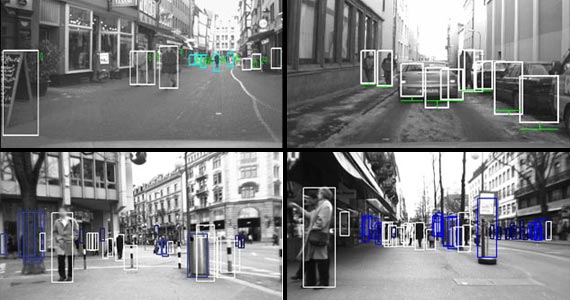U.S. Department of Transportation
Federal Highway Administration
1200 New Jersey Avenue, SE
Washington, DC 20590
202-366-4000
Federal Highway Administration Research and Technology
Coordinating, Developing, and Delivering Highway Transportation Innovations
| ARTICLE |
|

|
| Four examples of pedestrian detection using the proposed system. In the figures, the white boxes indicate possible pedestrians, and the blue boxes indicate possible pedestrians to be further analyzed by an appearance classifier. Both true detections and typical false positives are shown. The objective of the following modules is to reduce the false positives. |
Innovative technologies are urgently needed to detect pedestrians and other vulnerable road users at designated crossing locations and midblock and unexpected areas where they are experiencing increased exposure to dangerous traffic. According to the National Highway Traffic Safety Administration Fatality Analysis Reporting System’s statistics obtained from http://www.nhtsa.gov/FARS, there were 4,432 pedestrian fatalities in the United States in 2011. Pedestrian-related traffic crashes in 2011 accounted for 14 percent of the total fatalities.
In 2007, the Federal Highway Administration’s (FHWA) Exploratory Advanced Research (EAR) Program awarded a project to Sarnoff Corporation for a Layered Object Recognition System for Pedestrian Sensing. The researchers wanted to produce a system with a high detection rate and a low false positive (FP) rate, coupled with inherently low-cost sensing technology for potential widespread adoption.
The research team used stereo vision cameras and developed three key innovations, namely the detection and recognition of multiple roadway objects; use of multiple cues (depth, motion, shape, and appearance) to detect, track, and classify pedestrians; and use of contextual information to reject a majority of the typical false positives that plague vision-based pedestrian detection systems.
The researchers developed a report that describes the approach and tabulates the results of experiments conducted on multiple video sequences captured over the course of the project. The conclusion derived from these results is that the developed system is state of the art when compared to the best approaches published in literature. The false positive rates are still higher than desired for the system to be ready for commercialization. The report also provides steps that can be taken to improve these issues. A real-time system was developed and demonstrated in a test vehicle. The report is available at https://www.fhwa.dot.gov/publications/research/safety/11056/index.cfm.